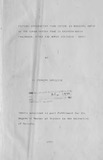| dc.description.abstract | In view of the emphasis given to improving
farm productivity in the marginal areas, the main
objective of the study was to determine those factors
that influence farm incomes in these areas. other
minor objectives were to determine the relative
importance of these factors, and to establish whether
their relationship with farm productivity depended on
the method used to derive farm income.
The literature review indicated that various
factors have been,shown to influence farm income in
the semi-arid areas as well as in other environments.
Those that are considered in this study are the following;
purchased farm inputs, crop area, labour,off farm
income, sex of the farm operator, assets, family size
and structure, the natural environment as defined by
district, and the ease of transportation as specified
in terms of the distance from nearest sizeable
market to the holding.
The source of data was the Integrated Rural Survey
1 (IRS 1) of 1974/75 carried out by the Ministry of
Finance and Planning. The analysis involved calculations
of percentages, frequency distributions, correlation
and regression coefficients and differences between the
means of subsamples.
Three methods were used to calculate gross farm
income and net farm income by taking into account
that (a) livestock valuation change may be included
or excluded in the calculation of farm income, and
(b) as the data was collected during a drought period,
an attempt can be made to offset the drought bias.
Gross crop output was also considered as an independent
variable.
It was found that although purchased farm input
(fertilizer, seed, spray and machinery expenses) was
the most important single factor influencing farm
income and crop output, there was limited dependence
on fertilizer, seed and sprays. Machinery expenses
was the only specific purchased crop i~put significant
in explaining the variation in crop output. The
importance of this variable seems to stress the impact
late planting and weeding have on crop output in
marginal areas.
Crop area was shown to be positively related to
farm income. However this was not indicated by the
regression equation that had gross crop output as the
dependent variable. Further analysis showed that
different groups of farmers operating the same size of
crop area had significantly different farm income. This
was caused by significant differences in the amount of
other factors used especially purchased crop inputs.
Both family and hired labour were significant in
influencing farm income and crop output. Nevertheless,
significant differences in gross crop output was
detected between two groups of farmers who had
comparable crop labour. Those that had a higher
proportion of family labour achieved higher gross
crop output than those who operated using a bigger
amount of hired labour. Although further analysis
in this connection was not possible in the study, the
observation seems to imply that family labour
contributes more to the success of small-scale farming
than the same amount of hired labour.
With respect to off-farm income, the correlation
and regression coefficients denoted that the relationship
between this factor and farm income is small but
negative. This finding supports observations made in
the study area while it is contrary to other suggestions
made on the basis of national sample of IRS 1. The
farmers who have high off-farm income, hired significantly
more labour but they did not purchase signifi-.
cantly more inputs. Off-farm income seems to offer an
alternative to farming as the major source of livelihood
in addition to competing for labour.
Farms operated by women were found to have
significantly lower farm income and crop output than
those managed by men. This is contrary to what was
observed in high potential areas and confirms previous
findings from the study area. The analysis implied
that this is likely to be the result of the following
factors; (a) women managers are associated with
much higher off-farm income than men operators, (b)
they use lower purchased farm inputs especially
those that involve machinery expenses, and (c) they
operate with lower family labour.
Assets were assumed to be the indicators of the
"rich" farmers who could afford to purchase inputs
and hire labour. The correlation and regression
coefficients with respect to this factor and gross
farm income indicated a positive association. Family
size and structure, as measured in terms of consumer
equivalents, was found to be positively related to
farm income. Kitui District was shown to have lower
gross crop output than Machakos District, which has
higher and more reliable rainfall in general. The
variable specifying the distance from the holding to
the nearest sizeable market was not significant in
any of the regression equations.
In general there was little variation in the
relationship between the above factors and farm income,
whether farm income was calculated including or
excluding livestock valuation change, or compensating
for the bias caused by the drought year. The gross
farm income showed stronger relationship with these
factors than net farm income. | en |

